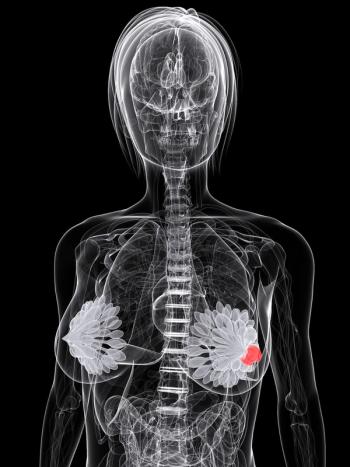
Oncology NEWS International
- Oncology NEWS International Vol 9 No 1
- Volume 9
- Issue 1
Multiple View Ultrasound Aids Breast Lesion Characterization and Biopsy Needle Tracking
CHICAGO-A new ultrasound technology that amasses as much as nine times more information than conventional ultrasound provides greater detail in characterizing breast lesions and also allows real-time tracking of the entire path of the breast biopsy needle, Jacques Souquet, PhD, senior vice president and chief technology officer at ATL Ultrasound (Bothell, Washington), said in an interview with ONI.
CHICAGOA new ultrasound technology that amasses as much as nine times more information than conventional ultrasound provides greater detail in characterizing breast lesions and also allows real-time tracking of the entire path of the breast biopsy needle, Jacques Souquet, PhD, senior vice president and chief technology officer at ATL Ultrasound (Bothell, Washington), said in an interview with ONI.
The new device, called SonoCT Real-Time Compound Imaging, was introduced to the US market at the 1999 annual meeting of the Radiological Society of North America (RSNA).
The SonoCT gathers images from several viewing angles and then combines them into a single image in real time, much like other compound imaging modalities such as computed tomography and magnetic resonance imaging.
Because SonoCT combines multiple looks at the same organ or tissue through various angles, it can reduce noise and artifacts, such as shadowing and refraction, that degrade conventional real-time ultrasound images, Dr. Souquet said. It reduces speckle and clutter, which increase noise and decrease image contrast, and it keeps on capturing signals even when echo interfaces do not occur at a 90-degree angle, he noted. These advantages improve imaging of normal and malignant breast tissue.
Because conventional ultrasound looks at the curvilinear breast from a single vantage point, it may miss important aspects of breast anatomy, such as microcalcifications, Dr. Souquet said. Conventional ultrasound does not provide clear delineation of lesion borders or the content of lesions, he added.
With conventional ultrasound, we know there is a mass in the breast because it casts a shadow, but we can just barely see the border of the lesion. There also is so much noise, it is difficult to characterize the kind of mass youre looking at, Dr. Souquet said. By having the capability of looking at the same pathology from various directions, SonoCT provides a continuous, well-delineated border of pathologies and more detail about the structures within a mass.
SonoCT improves the recognition of microlobules or spicules along the margin of a breast lesion, which signal invasive carcinoma, for example, he noted.
The SonoCT compounding technology collects images from actual structures but suppresses those from random echoes or artifacts, helping to more clearly depict fibroadenomas with their smooth, well-defined margins and homogeneous internal echoes (see Figure 1).
SonoCT also enhances localization of the biopsy needle during breast tissue sampling (see Figure 2). With conventional ultrasound, you can see the start of the insertion of the biopsy needle in a breast lesion, but then the signal is lost. With SonoCT, we interrogate the fields through various cycles and provide better visualization of the needle going all the way through the nodule during biopsy, Dr. Souquet said.
The SonoCT Real-Time Compound Imaging technology can be added to ATLs HDI 5000 system as an upgrade for imaging not only breast tissue but also musculoskeletal soft tissue, the scrotum, thyroid, and peripheral vasculature, Dr. Souquet said.
Articles in this issue
almost 26 years ago
New Strategies for Treating Ovarian Canceralmost 26 years ago
Researchers See More Effective Lung Cancer Screening, Therapyalmost 26 years ago
Goserelin Reduces Breast Ca Recurrence in Younger Womenalmost 26 years ago
ODAC Recommends Approval of Targretin for Advanced CTCLalmost 26 years ago
IOM Assessing Early Breast Cancer Detection Technologiesalmost 26 years ago
CRFA Honors Three With Its 1999 FrontLine Awardsalmost 26 years ago
Aromasin, New Hormonal Agent, Approved for Breast Canceralmost 26 years ago
LEDs Developed by NASA Used to Ablate Brain Tumorsalmost 26 years ago
Early Androgen Deprivation Beneficialalmost 26 years ago
Higher-Dose RT May Improve Prostate Cancer OutcomeNewsletter
Stay up to date on recent advances in the multidisciplinary approach to cancer.
















































































